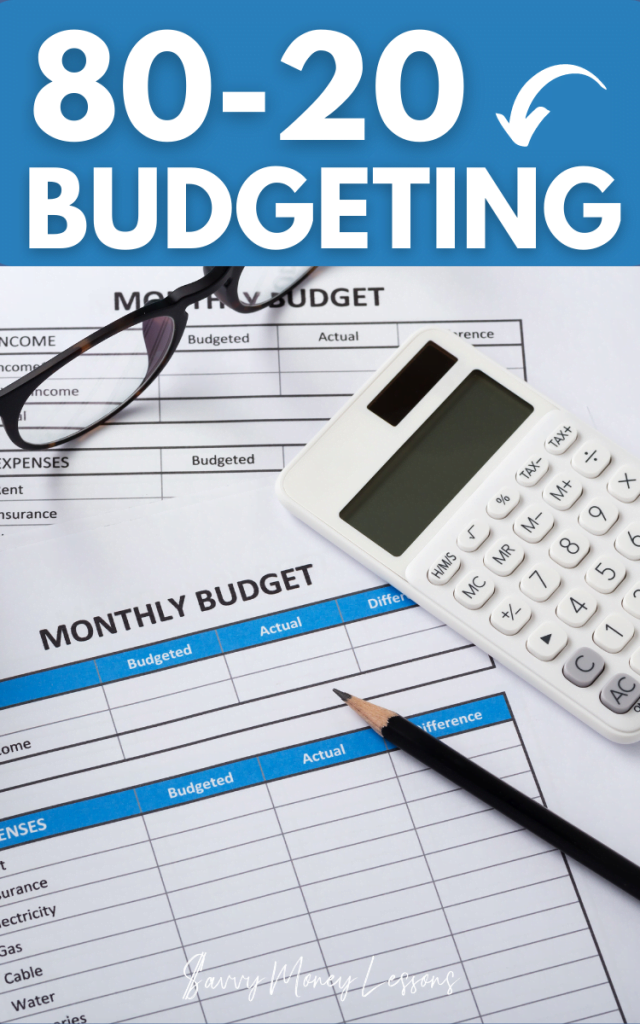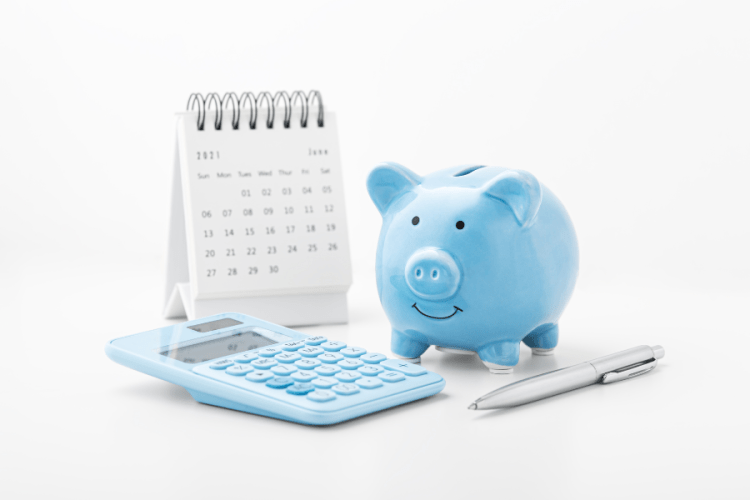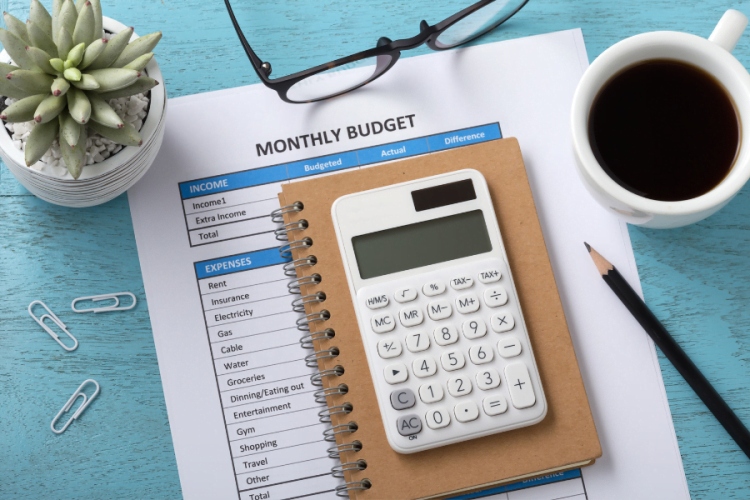80/20 Budget: How to Apply This Simple Budgeting Rule
This post may contain affiliate links, which means I may earn a small commission if you click and make a purchase. You can read our full disclosure policy here.
Last Updated on July 1, 2023 by Rebecca
If you’re looking for a way to balance your spending habits with saving, the 80/20 budget can help. The 80 20 budgeting method says that you should allocate 80% of your monthly income to expenses, with the remaining 20% going to savings.
Setting up an 80-20 rule budget can be a great way to work toward your financial goals in an uncomplicated way. If you’ve struggled with sticking to a spending plan or you’re tired of having no money left over to save at the end of the month, it might be time to give a different budgeting method a try.

Want free money?
Check out my favorite apps for making extra money and earning cash back!
Survey Junkie. Earn up to $50 per survey for sharing your opinions
Swagbucks. Make money playing games and watching videos ($5 bonus!)
InboxDollars. Take surveys and get paid for your opinions
Rakuten. Earn up to 40% cash back, plus get $30 for each person you refer
CashApp. Get $5 free when you use code ‘VZXRXZN’ to join CashApp
Writers Work. Earn extra cash from your writing skills!
Table of Contents
What Is the 80/20 Budget Rule?
The 80 20 budget is a personal finance rule that suggests putting 80% of your income toward needs and wants while using the other 20% to fund savings goals.
This type of budget system is also called a “pay yourself first” budget since it emphasizes putting money into savings first before spending anything. And some people may refer to it as an anti-budget, thanks to its simplicity.
The 80/20 budget is a variation or spinoff of the 50-30-20 budget rule.
Proposed by Senator Elizabeth Warren and her daughter Amelia Warren Tyagi in their book, “All Your Worth: The Ultimate Lifetime Money Plan“, this rule of budgeting divides monthly take-home pay into three categories: 50% for necessities, 30% for wants and 20%for savings and debt repayment.
Along with 80-20 budgeting, the 50/30/20 budget has inspired other budget methods, including:
- 30-30-30-10 budgeting
- 10 10 80 budget
- 70 20 10 budget
- 60 30 10 budgeting
- 60 20 20 budget
These budgeting plans have the same thing in common: they all use percentages to calculate how much money goes into different budget categories.
Pro tip: Struggling to stay on top of expenses? Consider using a personal finance tool like Empower to track all of your financial accounts in one place.

How Does the 80/20 Budget Rule Work?
The 80 20 budget works by having you split your after-tax income into two main buckets: spending and saving. The amount of money that goes to each one depends on your post-tax income.
For example, say that you take home $5,000 a month after taxes. If you’re using the 80/20 method to budget, here’s how the math works out:
- $5,000 x 0.80 = $4,000 for spending
- $5,000 x 0.20 = $1,000 for savings
As with other budgeting methods, the 80/20 rule uses your take-home income to do the calculations. Your take-home income or post-tax pay is how much money you get to keep after taxes, retirement contributions and other deductions are taken out of your paychecks.
Why is that important?
Simply because if you’re using your gross pay to calculate spending categories for your budget, you’ll end up with skewed numbers. For best results, it’s smart to budget only based on what actually goes into your bank account on payday.
Pro tip: Budgeting isn’t just for teens and families. Even younger kids can try making a needs/want budget of their own to learn basic money skills!
How to Make an 80/20 Budget

Making a budget using the 80/20 rule is fairly simple. You’ll need to add up your take-home income, then calculate how much you have to spend and how much you’ll save for the month.
Step 1: Add up your after-tax income
The first thing to do when budgeting with the 80 20 rule is to know how much income you have to work with.
The best way to find your net income is to check your pay stubs. Your pay stubs should show your gross pass, then list out all of your deductions for things like:
- Federal taxes
- State taxes, if you live in a state that has an income tax
- Health insurance premiums
- Retirement savings plan contributions
At the bottom, you should see your take-home income or net pay. Your paystubs may show your net pay for the current pay period, month, quarter or year to date depending on your employer’s preferences.
You can also review bank statements to see how much money you’re getting if you receive your paychecks through direct deposit to your checking account.
Step 2: Calculate how much money should go to spending vs. saving
Once you know how much money you have to budget you can figure out what you’ll have to spend and what you’ll save.
- To find your spending amount, multiply your net income by 0.80
- To find your saving amount, multiply your net income by 0.20
If your income stays the same from month to month, you may only have to do this calculation one time. But if your income fluctuates, then you’ll have to rerun the numbers each time you sit down to make a budget for the next month.
For example, say that you get a year-end bonus at work and your monthly take-home pay ends up being $8,000. You’d be able to spend $6,400 of that if you wanted to ($8,000 x 0.80 = $6,400) and save $1,600 ($8,000 x 0.20 = $1,600).
The next month, however, you get no bonus and you’re back to your regular after-tax income of $4,000. Your spending amount would drop to $3,200 ($4,000 x 0.80 = $3,200) while your savings percentage would be $800 ($4,000 x 0.20 = $800).
The great thing about the 80/20 budget rule is that it doesn’t matter how much money you make (or how little). You’re always using the same simple calculations to figure out how much you can spend or save.

Ready to get your budget together?
Grab our monthly budget worksheet, spending tracker and debt repayment tracker when you join the Savvy Money Lessons email list!
Step 3: Put 20% of income into savings
The 80/20 budget says you should pay yourself first by saving 20% of your income. (If you’re not familiar with the idea of paying yourself first, you can read about it in this book by David Bach. He’s the personal finance guru who advocates cutting out your daily coffee to build savings.)
Here’s what paying yourself first means in simple terms: you put money into savings before you pay bills or spend money on needs and wants.
Where are you supposed to keep your savings? It depends on your financial goals.
High-yield savings account
A high yield savings account is a great place to keep your emergency fund because you can keep your money accessible and earn a great interest rate.
An emergency fund represents the money you earmark for unexpected expenses. So if your car breaks down or you get laid off from your job, you could dip into your emergency savings to cover expenses temporarily.
How much should you save for emergencies?
If you’re following the Dave Ramsey baby step method, then you’d start with $1,000 initially. That’s usually enough money to cover a minor emergency.
From there, you’d build up your emergency fund until you have three to six months’ worth of expenses saved.
That’s a general rule of thumb. You could save more or less, depending on your income, how many people are in your family, your bills and what other financial resources you might be able to use if you need extra money.
Pro tip: Set up an automatic withdrawal from your checking account each payday for hassle-free savings.
Grow your money faster! Want to get a great rate on your savings? Open a high-yield savings account to earn the most competitive APY on deposits.
Certificate of deposit accounts (CDs)
A CD account is a special kind of savings account that pays you interest for a set time period.
You put money into your CD and agree to leave it there for a specific term. While it’s there, the bank pays you interest.
Once your CD matures, you can withdraw your initial deposit and the interest earned or roll it all into a new CD.
CDs are usually a good option if you’re saving for mid to long term goals when you know you won’t need the money right away.
One thing to know about CDs is that withdrawing money early could cost you interest. Banks can charge a penalty fee if you withdraw CD savings before the account matures.

Retirement accounts
Saving for retirement is an important goal since you can’t count on Social Security to meet all of your unique needs.
While pension funds are fading out, lots of people have access to a retirement plan at work. You might be able to save in a 401(k), 403(b) or similar plan, depending on where you work.
If you don’t have a retirement plan at work, or you want to save money in addition to what you’re putting into your plan, you could set up an Individual Retirement Account (IRA).
An IRA is a tax-advantaged savings account that’s designed just for retirement savings. There are two types of IRAs you can open:
- Traditional IRA: Traditional IRAs allow for tax-deductible contributions and withdrawals are taxed as ordinary income.
- Roth IRA: Roth IRAs don’t allow for deductible contributions but qualified withdrawals are tax-free.
You can invest in mutual funds, exchange-traded funds and other securities through an IRA. If you’re not sure how to create an investment strategy that fits your needs, that’s something a financial advisor can help with.
An advisor can look at how long you have to save until retirement, your risk tolerance and income to help you choose the right financial products and asset allocations. Advisors and financial planners take a bigger picture approach to help you take control of your money and build your net worth.
If you’re not quite ready to work with an advisor yet, you might consider a robo-advisor instead. Robo-advisors look at your financial situation and make investment decisions for you, using a special algorithm.
Taxable investment accounts
A taxable brokerage account lets you add different investments to your portfolio that you choose based on your risk tolerance and goals. These accounts are separate from your retirement investments and some of the things you might be able to buy include:
- Individual shares of stock
- Mutual funds
- Index funds
- ETFs
- Cryptocurrency
- Options
- Commodities
- Real estate investments
Here’s the simplified version of how brokerage accounts are different from retirement accounts. Retirement accounts enjoy some tax benefits; brokerage accounts don’t.
There’s no hard and fast rule on how much money you should put into a taxable brokerage account. A good rule of thumb is to make retirement accounts the first place you save to get those oh-so-valuable tax benefits, then put any extra money you have into a brokerage account.
College savings accounts
One of the most important parts of financial planning as a family centers on preparing for college.
If you want your kids to be able to get an education without taking on student loan debt, then you’ll need to have a plan. Some of the different ways you might pay for college include:
- Funding a 529 college savings account
- Opening a Coverdell Education Savings Account (ESA)
- Using money from a Roth IRA
- Buying education savings bonds
- Saving in a high yield account or CD
A 529 savings plan offers some important tax benefits. Contributions grow tax-deferred and as long as you’re withdrawing money for qualified educational purposes only, distributions are tax-free.
You could also talk to your child about other ways to pay for school if you’re not able to save as much for it as you’d like.
For example, you could encourage your teen to get a job or start a side hustle to make extra money for school. And of course, it might be well worth your time to help them look for scholarships and grants to pay for college.
Ready to start saving? Try the 100 Envelope Savings Challenge and discover that saving money is easier than you think!
Step 4: Allocate 80% of income to expenses

Once you’ve handled the savings part of the 80/20 budget, the next step is covering expenses.
An 80 20 budget doesn’t distinguish between needs vs. wants or different spending categories; everything goes into one pot. So it’s up to you to decide how you want to categorize expenses.
For example, you could take a simple approach and have one pot for “needs” and another for “wants”.
Your needs include all of the monthly bills and expenses you need to pay to maintain a basic standard of living. The major categories of needs usually include:
- Mortgage payments or rent payments
- Utility bills
- Groceries
- Insurance
- Transportation
You could also include childcare expenses here if you have to pay for daycare, a babysitter or a nanny so that you can work. Other required bill payments include child support or alimony if you’re ordered to pay them by the court.
It’s important to pay your most important monthly bills first before you spend any money on non-essential. Nonessential or discretionary expenses include things like:
- Gym membership fees
- Streaming or subscription services
- New clothes
- New toys for the kids
- Travel
- Hobbies and recreation
- Meals out
- Nonessential personal care, like salon visits
How much money goes to needs vs. wants is up to you. If you need a simple way to split things up, you could put 50% to needs and 30% to wants. Or you might split needs and wants evenly if your basic living expenses aren’t that high.
The most important thing is to find a system that works for you and leaves you with enough money to pay your highest-priority expenses.
80/20 Budgeting and Debt Repayment

So far, we haven’t mentioned anything about including debt repayment in an 80/20 budget. Since this budget system recommends saving 20% of your after-tax income, any debt payments you plan to make would come from the other 80% of your budget.
That includes minimum payments and any additional debt payments you make to:
- Credit card debt
- Auto loans
- Student loans
- Lines of credit and other installment loans
- Medical bills
Paying off debt is a key money management skill if you’re trying to achieve financial stability. There are different ways to approach paying down debt.
Pro tip: Transferring high-interest rate credit debt to a card with a 0% APR could save money and help you pay off debt faster. You can easily compare balance transfer offers on CreditKarma.
Debt snowball
The debt snowball method says you should rank all of your debts from smallest balance to lowest, then pay them off in that order.
You’d pay as much money as possible to the first debt on the list and make minimum payments to everything else. Once you pay off the first debt, you’d roll its payment over to the next debt on the list.
Debt avalanche
The debt avalanche method says to rank your debts from highest interest rate to lowest and pay them off in that order. You’d still pay as much as possible toward the first debt while making minimum payments to the rest. And as you pay off each debt, you’d roll its payment over to the next one.
Between the two methods, the debt avalanche offers maximum value in terms of interest savings. By paying off your most expensive debts first, you can make a big debt in the interest charges.
Using a budget calculator can be a good way to see how much extra money you might have to pay down debt. You can also go through your family budget line by line to look for expenses to reduce or eliminate so that you have more money for debt repayment.
Pro tip: Consider using a low-rate personal loan to consolidate debt and save money on interest.
80/20 Budget Rule Calculator
Looking for a handy calculator that you can use to make an 80/20 budget? Here’s a free one to help you run the numbers.
Just enter your take-home pay in the top box and hit ‘Calculate’ to break down your spending and saving amounts.
Budget Calculator
Recommended Budget Binders
Using a budget binder is a helpful way to keep track of spending, savings and debt repayment. Here are a few of my favorite budgeting planners for managing your money.
Frequently Asked Questions (FAQs)
What is the 80/20 rule?
The 80/20 rule is often associated with the Pareto principle, developed by Italian economist Vilfredo Pareto. This rule says that 20% of your efforts produce 80% of your outcomes. When you’re talking about 80/20 budgeting, it means splitting your income up so that 80% goes to spending while 20% goes to savings.
What is the 80-20 rule Dave Ramsey?
Dave Ramsey’s 80 20 rule says that 80% of managing your finances is your behavior, or what you do, and 20% is your knowledge or what you know. Following this rule could help you improve your financial health if you’re taking what you’re learning about money management and applying it strategically.
How does zero-based budgeting work?
Zero-based budgeting is a budget method that dictates giving every single dollar of income a job. The goal is to have no money left over. Instead, all of your income is assigned to specific expenses, savings goals or debt repayment. A zero-based budget could be a good fit if you prefer to get extremely detailed with budgeting and assigning expenses to different categories.
What is the 80 10 10 budget?
The 80 10 10 budget is a budget rule that says you should allocate 80% of your income to expenses, 10% to savings and 10% to debt repayment and charitable giving. This budgeting system is similar to the 80/20 rule but it has you commit less of your income overall to saving.
Final Thoughts on the 80/20 Budget
The 80-20 budgeting system could help you get your finances under control, without requiring you to do a lot of math or set up a special 80/20 rule spreadsheet. (Though you could do that if you’re a fan of spreadsheets.) The good news is that if you’ve read this far, you’re probably ready to get a handle on your finances. And learning how to make a budget is a good first step to make toward financial freedom.
Need more money tips? Read these posts next:
- Money Tips for Teens: 12 Smart Ways to Budget, Earn and Save
- How to Make a Budget in 5 Easy Steps
- 8 Important Money Lessons Kids Need to Know
Have you tried the 80 20 budget?
About the Author
Rebecca is a certified educator in personal finance (CEPF) and a money-saving expert. As a single mom of two teens, she knows all about the importance of family budgeting and financial goal-setting. She shares her best tips about saving and managing money at Savvy Money Lessons. You can also read her work online at Bankrate, Forbes Advisor, Investopedia and other top publications. Learn more








![Importance of a Family Budget and How to Make One [2023]](https://savvymoneylessons.com/wp-content/uploads/2023/02/Jobs-for-10-Year-Olds-to-Make-Money-640x1024.jpg)



![Gardening to Save Money [8 Smart Tips to Cut Your Food Budget!]](https://savvymoneylessons.com/wp-content/uploads/2021/06/Gardening-Tips-to-Save-Money-640x1024.jpg)

4 Comments